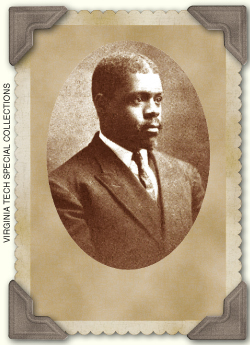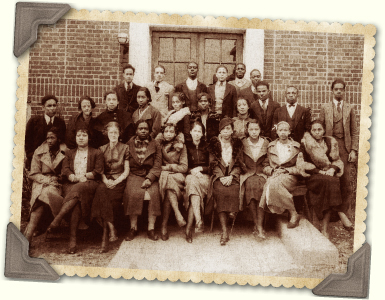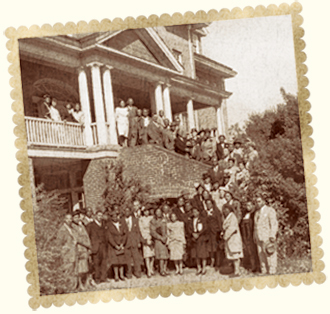Growing tired of seeing their alma mater fade away, a group of Christiansburg Institute (CI) alumni joined forces in 1976 to save the last three buildings standing. The skeleton of the two-story, Georgian brick building, known as the Edgar A. Long Building, is the outstanding remaining physical evidence of CI and the century of education it provided for the region's African Americans.
THE INSTITUTE'S PAST
The close of the Civil War left hundreds of former slaves and their children with freedom but little opportunity. Blacks had been denied education, and now, thirsting for it, they crowded into one-room schools established and run by people who knew that education was the key to success.
Christiansburg Institute, founded in 1866, was one of those schools. Initially called the Hill School, it was operated by Charles S. Schaeffer, a white ex-Union officer working with the Friends' Freedmen's Association (FFA) of Philadelphia. This one-room school and a sister school in the district served 300 black students. To accommodate so many students, Schaeffer and the FFA, a Quaker organization, raised funds for additional school buildings, giving birth to Christiansburg Institute.
|
|
 |
|
|
Edgar A. Long, second principal
of Christiansburg Institute
|
|
|
|
Booker T. Washington, founder and principal of Tuskegee Institute, became CI's supervisor in 1895. Washington promoted peaceful race relations in addition to black pride, group support, and vocational training. Under his watch, the school evolved into the Christiansburg Industrial Institute. The curriculum was both academic and vocational, offering such courses as English, math, history, and Bible, as well as cooking, sewing, carpentry, and animal husbandry.
By 1924, the industrial institute was a state-accredited high school, but the local public school board did not assume responsibility for its operation until 10 years later. In 1947, "Industrial" was dropped from the name, and Christiansburg Institute joined Virginia's segregated public school system.
Although the Supreme Court had ruled segregation unconstitutional in 1954, it took the 1964 Civil Rights Act and the threat of withdrawing federal funds to spur Virginia to react. Rather than integrate CI, the school board abandoned it. Much of the campus was auctioned off; the remaining land was set aside for the building of a desegregated Christiansburg High School.
PRESERVING AND PROMOTING A LEGACY
Preventing the wrecking ball from crashing through the Long Building, now a Virginia Historic Landmark, was the first organized effort to preserve CI. That effort continues to gain momentum, thanks to the work of Christiansburg Institute Inc. (CII), a nonprofit organization founded in 1996 to "preserve and promote the historic Christiansburg Institute through enacting its legacies of education, service, and excellence." CII is now working with local governments and universities to reopen Christiansburg Institute--as a museum, archive, and community learning center. "The hope for the institute is that it will be integrated into the community in a meaningful way," says Elaine Carter, CII executive director.
|
|
|
 |
|
|
The school board may have closed CI's doors to avoid integration, but today, integration will reopen those doors. CII is working with Virginia Tech, Radford University, the towns of Christiansburg and Blacksburg, and Montgomery County to become an asset to the present and future community.
THE ANT AND THE ELEPHANT
The relationship between Virginia Tech and CII began in 1992 and continues to evolve, with CII moving from the university's peripheral vision into clearer focus during the past two years. "You can only be a partner when there is mutual interest, when there is mutual gain," says Carter. "If you look at it as the ant and the elephant, what is it that we have to offer?"
Virginia Tech sees an opportunity for engagement, an integral part of its mission as a land-grant university. Early ties to CII involved the university's Service Learning Center and several professors in the College of Arts and Sciences (now the College of Liberal Arts and Human Sciences). These ties still exist, but the university is also "finding areas of activity that not only meet the needs of that community asset [CI] but also inform the scholarship and advance the strategic interest of the university," says John Dooley, vice president of Outreach and International Affairs. "From our standpoint, we would like to see ways in which our students can be actively involved in both teaching and learning at CI--for it to become a laboratory for our students. I see loads of opportunity for service learning."
|
|
 |
|
|
|
Associate professors of history Dan Thorp and Tom Ewing, involved in the collaborative efforts, have observed the opportunities CI makes available to students assisting with the research and archiving. "This department is beginning to provide some training for our students who are interested in going into public history for a career," says Thorp, who chairs the department. "We'd like to provide them with the opportunity for more hands-on experience. That's one element of our partnership."
The collaboration provides CI with university resources, contacts, and expertise as Virginia Tech makes available resources that CII would otherwise not have access to. "The weight of Virginia Tech taking an interest in us escalates us," says Carter. "It's a breakthrough of university-community relationships. The relationship has to stand up against time. It has to engage enough energy that it will be an appropriate and legitimate thing for the university to do."
ANSWERS FOR THE FUTURE
Christiansburg Institute's lifelong legacies--intergenerational learning, individual fulfillment, responsible and active citizenship, equality, and justice--are ideals to still aspire to. "Elaine has been very consistent in always wanting to address those larger issues and pursue those larger questions," Ewing says. "She sees the project not only as preserving the memory of that particular institution, but using it also as an example of these larger processes having to do with race, opportunity, equality, justice."
"How do you get people who have been enslaved and brutalized to become the kind of citizens the United States has today?" Carter asks. "How do you get that? How do you get people to cope with who they are at the same time that the world is oppressing them because of who they are?
"These are the kinds of questions Christiansburg Institute has answers to. These are the kinds of questions that we believe can deal with most marginalized people, whether they be in the trailer park, whether they be ex-felons, whether they be immigrants, refugees, or lost. We know how to suffer and somehow not become totally destructive." Carter pauses. "These are the kinds of things CI can bring to communities."
Christiansburg Institute's second century is dedicated to more than just its past. It may hold some answers to questions of the present--and of the future.

